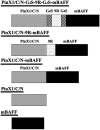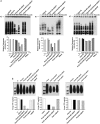Selective killing of Burkitt's lymphoma cells by mBAFF-targeted delivery of PinX1
- PMID: 21102426
- PMCID: PMC3049869
- DOI: 10.1038/leu.2010.261
Selective killing of Burkitt's lymphoma cells by mBAFF-targeted delivery of PinX1
Abstract
Increased expression of BAFF (B cell-activating factor belonging to the TNF family) and its receptors has been identified in numerous B-cell malignancies. A soluble human BAFF mutant (mBAFF), binding to BAFF receptors but failing to activate B-lymphocyte proliferation, may function as a competitive inhibitor of BAFF and may serve as a novel ligand for targeted therapy of BAFF receptor-positive malignancies. Pin2/TRF1-interacting protein X1 (PinX1), a nucleolar protein, potently inhibits telomerase activity and affects tumorigenicity. In this study, we generated novel recombinant proteins containing mBAFF, a polyarginine tract 9R and PinX1 (or its C/N terminal), to target lymphoma cells. The fusion proteins PinX1/C-G(4)S-9R-G(4)S-mBAFF and PinX1/C-9R-mBAFF specifically bind and internalize into BAFF receptor-positive cells, and subsequently induce growth inhibition and apoptosis. The selective cytotoxicity of the fusion proteins is a BAFF receptor-mediated process and depends on mBAFF, PinX1/C and 9R. Moreover, the fusion proteins specifically kill BAFF receptor-expressing Burkitt's lymphoma (BL) cells by inhibiting telomerase activity and the consequent shortening of telomeres. Therapeutic experiments using PinX1C-G(4)S-9R-G(4)S-mBAFF in severe combined immunodeficient (SCID) mice implanted with Raji cells showed significantly prolonged survival times, indicating the in vivo antitumor activity of the fusion protein. These results suggest the potential of PinX1/C-G(4)S-9R-G(4)S-mBAFF in targeted therapy of BL.
Figures






Similar articles
-
PinX1: structure, regulation and its functions in cancer.Oncotarget. 2016 Oct 4;7(40):66267-66275. doi: 10.18632/oncotarget.11411. Oncotarget. 2016. PMID: 27556185 Free PMC article. Review.
-
Tumor targeting of vincristine by mBAFF-modified PEG liposomes in B lymphoma cells.Cancer Lett. 2008 Sep 28;269(1):26-36. doi: 10.1016/j.canlet.2008.04.024. Epub 2008 Jun 4. Cancer Lett. 2008. PMID: 18534744
-
Treatment of acute lymphoblastic leukemia with an rGel/BLyS fusion toxin.Leukemia. 2012 Aug;26(8):1786-96. doi: 10.1038/leu.2012.54. Epub 2012 Feb 29. Leukemia. 2012. PMID: 22373785 Free PMC article.
-
The Pin2/TRF1-interacting protein PinX1 is a potent telomerase inhibitor.Cell. 2001 Nov 2;107(3):347-59. doi: 10.1016/s0092-8674(01)00538-4. Cell. 2001. PMID: 11701125
-
LPTS: A Novel Tumor Suppressor Gene and a Promising Drug Target for Cancer Intervention.Recent Pat Anticancer Drug Discov. 2015;10(2):170-5. doi: 10.2174/1574892810666141205111913. Recent Pat Anticancer Drug Discov. 2015. PMID: 25479038 Review.
Cited by
-
PinX1: structure, regulation and its functions in cancer.Oncotarget. 2016 Oct 4;7(40):66267-66275. doi: 10.18632/oncotarget.11411. Oncotarget. 2016. PMID: 27556185 Free PMC article. Review.
-
Formulation, Preparation and Evaluation of Nanostructured Lipid Carrier Containing Naringin and Coix Seed Oil for Anti-Tumor Application Based on "Unification of Medicines and Excipients".Drug Des Devel Ther. 2020 Apr 16;14:1481-1491. doi: 10.2147/DDDT.S236997. eCollection 2020. Drug Des Devel Ther. 2020. PMID: 32368009 Free PMC article.
-
PinX1 inhibits the invasion and metastasis of human breast cancer via suppressing NF-κB/MMP-9 signaling pathway.Mol Cancer. 2015 Mar 26;14:66. doi: 10.1186/s12943-015-0332-2. Mol Cancer. 2015. PMID: 25888829 Free PMC article.
-
PinX1 plays multifaceted roles in human cancers: a review and perspectives.Mol Biol Rep. 2024 Nov 17;51(1):1163. doi: 10.1007/s11033-024-10082-x. Mol Biol Rep. 2024. PMID: 39550726 Free PMC article. Review.
-
The BAFF/APRIL system: emerging functions beyond B cell biology and autoimmunity.Cytokine Growth Factor Rev. 2013 Jun;24(3):203-15. doi: 10.1016/j.cytogfr.2013.04.003. Epub 2013 May 15. Cytokine Growth Factor Rev. 2013. PMID: 23684423 Free PMC article. Review.
References
-
- Lyu MA, Cheung LH, Hittelman WN, Marks JW, Aguiar RC, Rosenblum MG. The rGel/BLyS fusion toxin specifically targets malignant B cells expressing the BLyS receptors BAFF-R, TACI, and BCMA. Mol Cancer Ther. 2007;6:460–470. - PubMed
-
- Nimmanapalli R, Lyu MA, Du M, Keating MJ, Rosenblum MG, Gandhi V. The growth factor fusion construct containing B-lymphocyte stimulator (BLyS) and the toxin rGel induces apoptosis specifically in BAFF-R-positive CLL cells. Blood. 2007;109:2557–2564. - PubMed
-
- Wang T, Zhao J, Ren JL, Zhang L, Wen WH, Zhang R, et al. Recombinant immunoproapoptotic proteins with furin site can translocate and kill HER2-positive cancer cells. Cancer Res. 2007;67:11830–11839. - PubMed
-
- Zhang L, Zhao J, Wang T, Yu CJ, Jia LT, Duan YY, et al. HER2-targeting recombinant protein with truncated pseudomonas exotoxin A translocation domain efficiently kills breast cancer cells. Cancer Biol Ther. 2008;7:1226–1231. - PubMed
-
- Novak AJ, Grote DM, Stenson M, Ziesmer SC, Witzig TE, Habermann TM, et al. Expression of BLyS and its receptors in B-cell non-Hodgkin lymphoma: correlation with disease activity and patient outcome. Blood. 2004;104:2247–2253. - PubMed
Publication types
MeSH terms
Substances
LinkOut - more resources
Full Text Sources
Molecular Biology Databases

